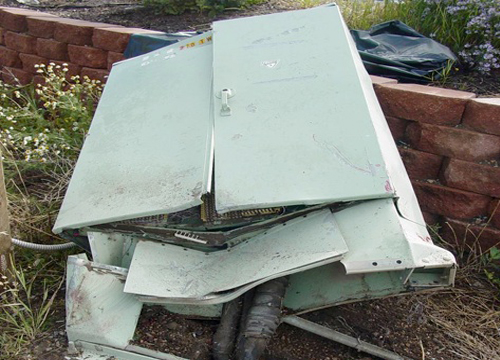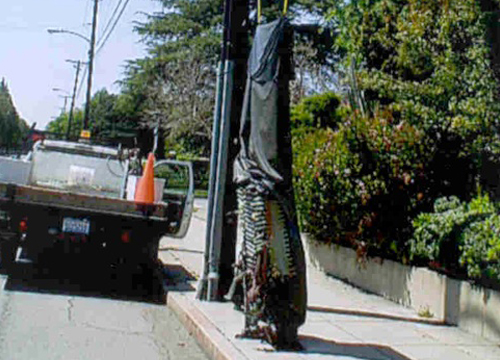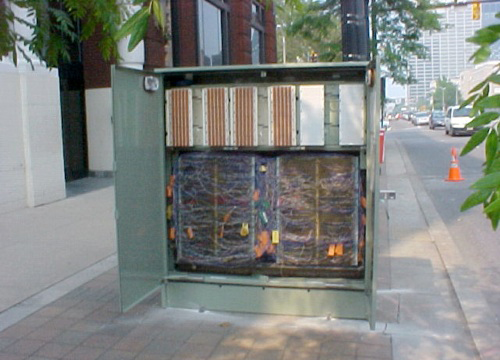
Cross-Connect Systems, through its parent company, Stockdale Communications Inc., is the patent holder of U.S. Patent number 6,861,584 B2, a patent covering a flush to grade vault with wall mounted cross-connect panels. The product was developed at the behest of SBC (now AT&T) to address SBC’s growing concerns that their above grade communications cabinets were encroaching on the pedestrian right of ways as defined in the American with Disabilities Act (ADA) and to address other service outage issues relating to vehicle damage, fires, floods, hurricanes and terrorist threats to the communication infrastructure.
In 2005, AT&T announced their “Lightspeed” program. A program designed to offer high-speed Internet services, VOIP, on demand pay per view TV and other bundled services to their customers. To achieve the goals of this program requires AT&T to add substantial infrastructure to their existing copper and fiber network. To add that infrastructure requires the addition of literally thousands of additional metal cabinets, and in most cases the expansion to larger metal cabinets plus additional electronic boxes at existing locations. In many cases the result is several larger metal cabinets where only one metal cabinet stood before. This proliferation of ugly metal cabinets on their lawns and street corners has many urban citizens in an uproar. (See Telecommunications Equality Coalition at http://www.cacities.org/story published by the League of California Cities). The cities have lost the fight for franchise fees as a means of controlling this proliferation of cabinets and thanks to the TELCO’S myth that “it is not feasible to place telecommunications equipment below grade”, the cities are left with trying to hide this proliferation of cabinets with landscaping.
This Municipal Presentation is intended explode that TELCO myth and to give the reader a comprehensive understanding of the issues facing our communities and to educate the reader concerning the CCS flush to grade product as an alternative to the traditional TELCO above grade metal cabinets.

Today the telephony industry utilizes above ground mounted cross connect cabinets equipped with frames, blocks and cable to provide service to their customers. These cross connect cabinets provide service to city/governmental agencies, financial institutions, hospitals as well as to the general populist. In the City of Los Angeles the number of cross connect cabinets is in excess of 6,000 cabinets. Above ground cabinets range in many sizes from 42¾” X 10½” X 7 ½” which is typically used to provide service to 70 customers up to 64¾” X 76¾” X 26” which is typically used to provide service to 2,700 customers.
The typical above grade cabinet is located on sidewalks, street corners and along main thoroughfares through out the United States. In addition to presenting yet another sidewalk obstacle to the handicapped, the existing above grade cabinets present many of the following issues to our cities.

An above ground cross connect cabinet is vulnerable to issues involving vehicular traffic. In many locations the height and width of existing ground mount cabinets’ present line of sight impairments. This impairment can contribute to traffic accidents involving vehicle to pedestrians as well as vehicle to vehicle.

An above ground cross connect cabinet is always vulnerable to service outage. Typical outages are caused by vehicles hitting the cabinet either accidentally (as pictured above), or intentionally, from wild fires that melt the plastic connectors, or from flood water that invades the cabinet resulting in outages. Regardless of reason, the result is the same-loss of service.

With the ever-growing urban population, our urban landscapes are increasingly cluttered with unsightly fixtures. Our city streets are a virtual obstacle course of power boxes, telephone boxes, streetlights, utility poles, bus benches, newspaper racks and signs. All of these fixtures suffer the indignities of graffiti and vehicular damage on a continuing basis. Removing as many of these fixtures from the street and placing them underground will greatly enhance not only the safety but also the esthetics of our cities.